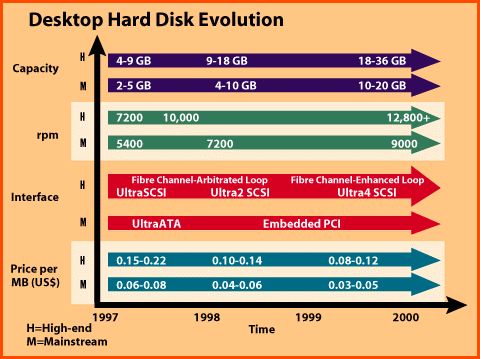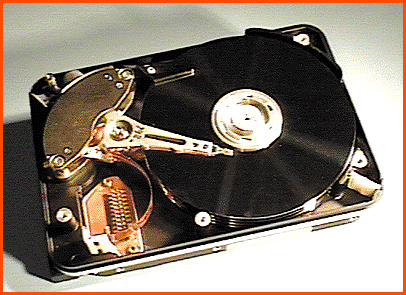9.1-GB drives spinning at 7200 rpm will soon enter the mainstream.
Nebojsa Novakovic
Despite many competing technologies, hard disk drives continue to hold
their dominant position as the medium of choice for data storage. The price
of hard disks continues to plummet, while capacity and performance climb
upward. Seagate and Quantum are expected to ship 9-GB Ultra2 SCSI drives
in mid-1998. The 3.5-inch-factor drives, which stand just 1 inch high,
spin at 10,000 rpm.
The higher the rotational speed of the disk drive motor the greater
the data transfer rate, and the lower the seek and latency times when the
head switches tracks. Today, most hard disks spin at 5400 rpm, with higher-end
models attaining a speed of 7200 rpm. The Seaga te Barr acuda,
Quantum Atlas, and Micropolis Tomahawk 7200 drives have become popular
in multimedia applications such as digital motion pictures.
Seagate is already shipping its first 10,000-rpm disk drives, the Cheetah
family. With formatted data transfer rates peaking at 16.8 MB per second
(around 40 percent better than top 7200-rpm hard drives), and prices around
40 percent higher than equivalent 7200-rpm offerings, these 4.5- and 9.1-gigabyte
drives are currently limited to niche market applications. Early next year,
however, Seagate will sell a new drive, the Medalist
Pro 9140 , that has a 9.1-GB capacity and spins at 7200 rpm. Street
price will be about $495, according to Denise Lippert, product marketing
manager.
Not all agree that high-end 10,000-rpm drives are a viable business
right now. David Rawcliffe, marketing director of Quantum Asia-Pacific,
says Quantum will offer 10,000-rpm models in mid-1998, when 10,000-rpm
drives might have 15 percent of the high-end hard disk market. Quantum's
first 10,000-rpm entries are expected to hold 9 GB and 18 GB, with either
Ultra2 SCSI or Fibre Channel interfaces. Rawcliffe also expects 10,000
rpm to remain the top hard disk rotational speed until early next decade.
Magnetoresistive (MR) heads, used by IBM and Quantum, helped achieve
the next level of capacity by separating the read and write functions into
two physically distinct heads. An inductive head, optimized for writing
information, is integrated with the MR structure optimized for reading.
MR heads are usually coupled with partial response maximum likelihood (PRML)
channel recording for resolving data pulses from the disk surface. While
the initial troubles in manufacturing MR heads limited their use to very
high-end drives, the yields have improved in the past two years. Major
vendors like IBM, Quantum, and Seagate use them in many mainstream IDE
drives.
The next step, Giant MR (GMR), enabling recording density in tens of
gigabit s per square inch, is expected to arrive next year in some 3.5-inch
drives with capacities well above 10 GB. Western Digital is already shipping
UltraATA IDE devices with 2.16 GB formatted capacity per platter (6.4 GB
for a three-platter hard disk) using MR head technology. In 1998, MR heads
are expected to overtake the old inductive ones in terms of number of units
shipped, analysts say.
Besides GMR and improvements to PRML, like IBM's PRML with digital filtering,
new technologies like multilevel decision feedback equalization (MDFE)
are expected to help achieve even higher capacities. Developed by Singapore-based
Data Storage Institute, MDFE is expected to surpass PRML and its derivatives
in recording density and performance.
On the high end, dual-head parallel drives, pioneered by Seagate, didn't
make it in the market. Seagate dropped its 2-GB Barracuda 2HP two years
ago, with no plans to use the technology in the future. While dual-head
parallel operation doubles data transfer speed for both r eads and writes,
similar speedups can be achieved by striping two identical drives on the
same or different SCSI connections. Data can be interleaved on a word or
sector basis, depending on whether your target application is graphics-
or database-oriented. Windows NT directly supports disk striping, joining
the drives into a single volume.
Makers of high-end drives do not need to follow the small incremental
steps in capacity seen in IDE drives. Instead of 2.1 GB, 2.5 GB, 3.2 GB,
4.3 GB, etc., the high-end arena has the simple capacity-doubling
rule : 2.2 GB, 4.5 GB, and 9 GB. The 18-GB Quantum Atlas III is presently
the highest-capacity 3.5-inch drive.
UltraSCSI, in its 20-MBps 8-bit and 40-MBps 16-bit versions, is now
the dominant high-end mass storage interface. Many high-end drives are
available in the most popular versions of this interface, including combinations
of narrow, wide, single connector attachment (SCA), and differential UltraSCSI.
Early next year, volume shipm ents of the first Ultra2 SCSI drives with
new LVD-Link (low voltage differential) transmitter technology will start.
The 16-bit version of Ultra2 SCSI not only doubles the transfer rate to
80 MBps, it also increases the maximum cable length from 1.5 to 12 meters.
The first PCI controller to provide Ultra2 Wide SCSI with LVD-Link is Symbios's
53C895 Ultra2 Wide PCI/SCSI I/O processor. The company is expected to offer
a dual-channel Ultra2 SCSI processor early next year on a 64-bit PCI bus,
the follow-on to its 53C876 dual-channel Ultra Wide SCSI PCI processor.
For the next year, there are more design improvements scheduled by the
ANSI XT310 committee, including compact packaging, tripled connector density,
and "smart silicon." With Ultra4 Wide SCSI, bus bandwidth will
increase to 160 MBps.
The Fibre Channel-Arbitrated Loop (FC-AL) provides serial interface
performance of 100 MBps per loop, with up to two loops connected to each
storage device. This unprecedented performance rate can be sustained on
links up to 10 kilometers long, with as many as 126 devices in a single
chain. Adaptec and Symbios were among the first to offer FC-AL PCI host
adapters earlier this year.
Quantum's Rawcliffe says the 1998 high-end focus will still be on Ultra2
SCSI with LVD, as the performance difference between it and FC-AL is not
so drastic, and there will still be around a 20 percent price differential
between otherwise identical drives in Ultra2 SCSI and FC-AL versions. Also,
FC-AL controllers will still be substantially more expensive, even with
single-chip implementations like the Adaptec AIC 1160 and the Symbios FC920.
Adaptec product manager Adam Zagorski states that the company expects "two
distinct markets to develop for Ultra2 SCSI and Fibre Channel. People will
use Ultra2 to support their legacy SCSI drives."
A year ago, Seagate and IBM agreed to merge Seagate-backed FC-AL and
IBM-backed Serial Storage Architecture (SSA) into one serial storage interface
standard dubbed Fibre Channel-Enhanced Loop ( FC-EL), combining SSA reliability
and FC-AL performance. It could become the dominant long-term high-end
mass storage interface, with performance moving toward 800 MBps and beyond.
Like FC-AL, FC-EL is both a network and a storage interface standard, supporting
Internet, ATM, and SCSI protocols, among others. The first FC-EL products
are expected in 1999.
But don't expect high-end drives that predict and warn you of their
failure. Self-Monitoring, Analysis, and Reporting Technology (SMART) is
not planned for most workstation and server systems next year.
Desktop Hard Disk Evolution
illustration_link
(21 Kbytes) 
PC hard disk capacity is expected to climb to 36 GB by the year
2000.
Gettin' Better All the Time
photo_link
(74 Kbytes) 
Seagate's new 9.1-GB drive is expected to sell for around $495 when
introduced early next year.





